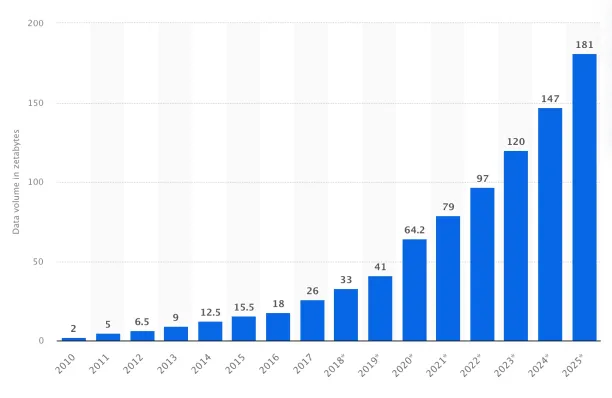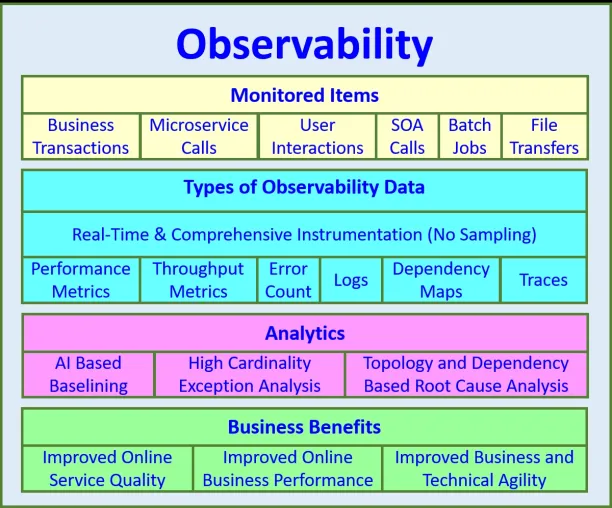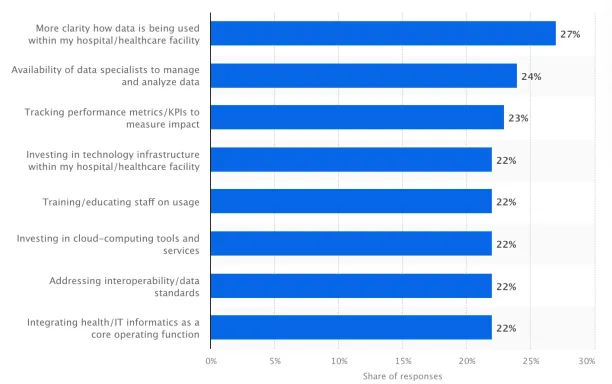Enhancing Data Quality Through Data Observability in 2024

Source: Statista
Figure 1. Volume of data worldwide between 2010-2020 and the estimations for 2021-2025
Share of new data in all data peaked in 2020 and continues to grow (See Figure 1). However, research shows that less than half of companies are managing data as a business asset and only 28% of companies have an established culture to engage with data.1
In the era of big data, ensuring data quality has become a critical aspect of business operations and data observability has emerged as a powerful tool in maintaining and enhancing data quality, significantly impacting decision-making and organizational success.
This article examines the relationship between data observability and quality, how high-quality data can benefit from data observability, and several use cases.
What is data quality and data observability?
Data quality: It refers to the accuracy, completeness, consistency, and timeliness of data.
Data observability: It is a comprehensive strategy for monitoring and managing the health and performance of data pipelines and systems. It also provides visibility into data quality, lineage, and changes, allowing organizations to identify and resolve issues, ensuring accurate and reliable data delivery.
The two notions are intrinsically related, as data observability helps to maintain and improve data quality, allowing organizations to make educated decisions based on reliable data.
What are the primary challenges due to data quality issues?
As organizations rely more on data for decision-making, data quality issues can have significant consequences, in the following manner:
- Compromised analyses: Data quality issues can lead to distorted or incomplete data, undermining the validity of data-driven analyses and potentially leading to misleading conclusions.
- Inaccurate insights: Poor data quality can lead to misrepresentation of underlying facts, resulting in insights that do not accurately reflect the true state of the business or market, stifling effective decision-making.
- Wrong business decisions: Flawed data can lead to incorrect assumptions and conclusions, resulting in business decisions that may not be in the best interests of the organization, ultimately affecting overall performance and growth.
How can data observability help? Top 7 data observability benefits

Source: APM Experts
Figure 2. Data observability business benefits.
Data observability addresses these concerns by providing a comprehensive view of the data ecosystem, allowing organizations to:
Improve data quality via
1. Proactive data quality assurance
~80% of company executives’ key focus of data investment in 2023 is to assure data quality.2 Data observability tools allow organizations to proactively identify and resolve data quality issues before they impact downstream processes or analyses. Data observability can help organizations detect anomalies, inconsistencies, and errors in their data systems. This can enable them to take timely corrective actions. This can reduce the likelihood of:
- Data corruption
- Data loss
- Data misinterpretation.
2. AI-powered approach
Data observability platforms often incorporate machine learning algorithms to analyze data patterns, predict potential issues, and suggest corrective actions. This intelligent approach allows organizations to identify and resolve data quality issues before they impact business operations and decision-making.
3. Enhanced data reliability
Data observability platforms offer real-time data quality dashboards that visualize key data quality metrics and indicators. These dashboards enable organizations to monitor data quality trends and proactively address issues, ensuring that data remains reliable, accurate, and consistent.
4. Collaborative data quality management
A data observability can foster a shared understanding of data quality across data teams too. Data observability can provide a shared understanding of data quality across teams.This can improve collaboration between data producers and consumers. By providing visibility into data assets, organizations can streamline communication and decision-making. This can ensure that all stakeholders are aligned and working towards the same goals.
Support business processes via
5. Ensuring regulatory compliance
Data observability can help organizations meet regulatory requirements by ensuring data accuracy and consistency. Thereby, it can reduce the risk of non-compliance penalties.
6. Increased operational efficiency
By enabling organizations to optimize their data pipelines and address data quality issues, data observability can contribute to increased operational efficiency. This can translate to:
- Reduced costs
- Faster time-to-insights
- More effective resource utilization by data scientists.
7. Enhanced decision-making and competitive advantage
Data observability tools offer data health scorecards that provide a comprehensive overview of an organization’s data quality status. These scorecards enable businesses to quickly identify areas needing attention, prioritize efforts, and track progress towards data quality goals. By continuously monitoring data pipelines and systems, data observability ensures accuracy and up-to-date information, leading to improved decision-making and increased business outcomes.
Embracing data observability allows organizations to gain a competitive advantage by driving innovation through informed decisions and responding effectively to market trends, ultimately helping them stay ahead of their competition and seize new opportunities.
7 applications of data observability for data quality enhancement
1. Predictive maintenance
Data observability can help manufacturers maintain data quality in their manufacturing processes, equipment, and inventory. Instant track of data and can help to enhance predictive maintenance algorithms, minimizing downtime, prolonging machine life, and enhancing overall efficiency.
2. Healthcare and precision medicine

Source: Statista
Figure 3. Factors that would help healthcare service providers utilize healthcare data
Data observability can enhance data quality, making it easier to make sense of the data. This can help healthcare systems to provide more accurate diagnoses, treatment plans, and patient monitoring. High-quality data is also essential for personalized medicine, where treatments are tailored to an individual’s genetic makeup and medical history.
3. Fraud detection and prevention
The value of e-commerce losses is predicted to increase to $48 billion in 2023, up from $41 billion in 2021.3 Data observability benefits financial organizations and e-commerce platforms by ensuring data quality in transactions, customer information, and behavioral patterns. Accurate and reliable data enables more effective fraud detection models, decreasing financial losses and increasing customer trust.
4. Market research and customer segmentation
In 2021, the use of big data analytics in market research have increased to 46%.4 Businesses can better understand their target audience, spot new trends, and establish effective marketing plans if they can have data quality in market research and customer data. Data observability offers data quality, resulting in more precise consumer segmentation and more targeted and effective marketing operations.
5. Supply chain optimization
The usage of big data analytics is predicted to be the major trend affecting supply chain organizations by 2025.5 Data observability can help organizations optimize their supply chains by maintaining high data quality across all stages, from procurement to distribution. Accurate, reliable data enables better decision-making, reducing costs, and improving efficiency throughout the supply chain.
6. Environmental monitoring and conservation
Data observability can enhance the quality of environmental data collected from sensors, satellites, and field studies. High-quality data enables more accurate assessments of environmental conditions, helping policymakers and conservationists make better-informed decisions to protect ecosystems and address climate change.
7. Smart city management
In 2023, the smart cities market is expected to be worth more than $580 billion.6 Smart cities rely on vast amounts of data from sensors, IoT devices, and other sources to optimize urban services and infrastructure. Data observability can help smart city administrators maintain high data quality, ensuring that data-driven decisions lead to better urban planning and improved quality of life for residents.
If you need help, don’t hesitate to contact:
External Links
- 1. “State of big data/AI adoption in organizations worldwide from 2019 to 2023.” Statista. Retrieved April 26, 2023.
- 2. “Data and Analytics Leadership Annual Executive Survey 2023.” Wavestone. Retrieved April 26, 2023.
- 3. “Online Payment Fraud“. Juniper Research. Retrieved April 26, 2023.
- 4. “Share of organizations using big data analytics in market research worldwide from 2014 to 2021“. Statista. Retrieved April 26, 2023.
- 5. “Leading trends anticipated to impact supply chains by 2025“. Statista. Retrieved April 26, 2023.
- 6. “Smart Cities Market Report.” Global Data. November 23, 2022. Retrieved April 26, 2023.

Cem is the principal analyst at AIMultiple since 2017. AIMultiple informs hundreds of thousands of businesses (as per Similarweb) including 60% of Fortune 500 every month.
Cem's work has been cited by leading global publications including Business Insider, Forbes, Washington Post, global firms like Deloitte, HPE, NGOs like World Economic Forum and supranational organizations like European Commission. You can see more reputable companies and media that referenced AIMultiple.
Throughout his career, Cem served as a tech consultant, tech buyer and tech entrepreneur. He advised enterprises on their technology decisions at McKinsey & Company and Altman Solon for more than a decade. He also published a McKinsey report on digitalization.
He led technology strategy and procurement of a telco while reporting to the CEO. He has also led commercial growth of deep tech company Hypatos that reached a 7 digit annual recurring revenue and a 9 digit valuation from 0 within 2 years. Cem's work in Hypatos was covered by leading technology publications like TechCrunch and Business Insider.
Cem regularly speaks at international technology conferences. He graduated from Bogazici University as a computer engineer and holds an MBA from Columbia Business School.
Sources:
AIMultiple.com Traffic Analytics, Ranking & Audience, Similarweb.
Why Microsoft, IBM, and Google Are Ramping up Efforts on AI Ethics, Business Insider.
Microsoft invests $1 billion in OpenAI to pursue artificial intelligence that’s smarter than we are, Washington Post.
Data management barriers to AI success, Deloitte.
Empowering AI Leadership: AI C-Suite Toolkit, World Economic Forum.
Science, Research and Innovation Performance of the EU, European Commission.
Public-sector digitization: The trillion-dollar challenge, McKinsey & Company.
Hypatos gets $11.8M for a deep learning approach to document processing, TechCrunch.
We got an exclusive look at the pitch deck AI startup Hypatos used to raise $11 million, Business Insider.
To stay up-to-date on B2B tech & accelerate your enterprise:
Follow on
Comments
Your email address will not be published. All fields are required.